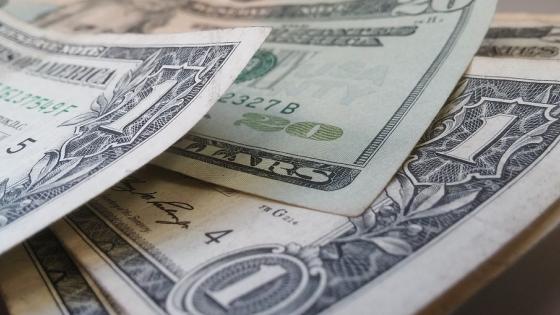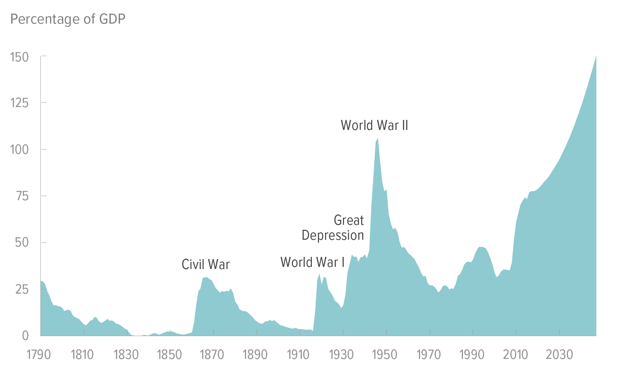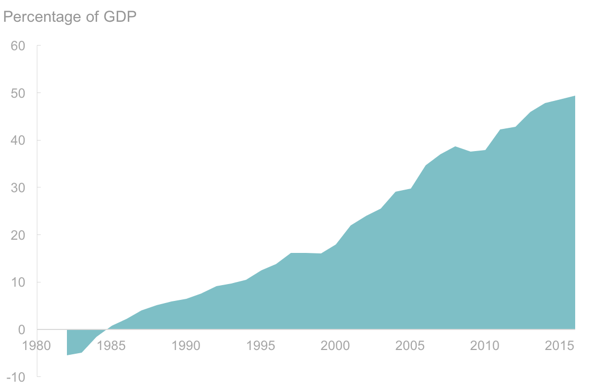The US fiscal outlook is bleak. The ratio of federal debt held by the public to GDP has rapidly increased from 30% in the early 2000s to 80% in 2017. Figure 1 shows that not only are current levels abnormal from an historical perspective – indeed, higher than at any time except for WWII – but they are forecasted to reach the unprecedented level of 150% by 2040. A similarly bleak picture emerges for the US external debt position. As shown in Figure 2, the US net external debt, most of it dollar denominated, has rapidly increased from 18% of US GDP in the early 2000s to a current level of 50%.1 The ongoing tax reform is likely to exacerbate these fiscal and external trends. An increase in interest rates from their historically low levels would quickly increase the associated fiscal and external burdens.
Figure 1 Federal debt held by the public
Source: CBOE.
Figure 2 US net external debt
Source: BEA.
Against this backdrop, the US dollar has so far maintained its hegemonic position at the centre of the international monetary system. This position is out of proportion with the lower and shirking relative economic size of the US. The dollar still accounts for more than 65% of total foreign exchange reserves according to the IMF. More generally, the US is still the single biggest supplier of safe assets to the rest of the world, as much as 50% of world GDP in 2016. Relatedly, the dollar is the principal monetary anchor; for example, more than 50% of countries that peg their exchange rate peg to the dollar (Ilzetzki et al. 2017). The dollar accounts for 43% of global trade invoicing (Gopinath 2016). Dollar-denominated bonds account for more than 60% of global cross-border positions (Maggiori et al. 2017).
Is the US putting its special position at risk by leveraging itself beyond its means? Will another currency take over if the confidence in the dollar evaporates? These are fundamental questions not only for the US but also for the world. In a recent paper, we develop a model of the international monetary system that helps answer these questions (Farhi and Maggiori 2017). Our framework allows us to interpret the cautionary lessons from history for our times.
The pound used to be the world’s reserve currency up until the 1920s, but lost this position to the dollar following its devaluation in 1931. Today, its role in the international monetary system is marginal. The closest precedent to the current situation is the chain of events that eventually brought the Bretton Woods system to an end. In 1959, Triffin exposed the fundamental instability of the US-centric Bretton Woods system and predicted its ultimate demise. He explained that the US was facing an insurmountable dilemma between satisfying the increasing demand for safe dollar assets and maintaining their safety. He prophesised that the US would stretch its position and expose itself to a confidence crisis that would force a devaluation of the dollar. Indeed, time proved Triffin right. Faced with a full-blown run on the dollar, the Nixon administration first devalued the dollar against gold in 1971 (the ‘Nixon shock’) and ultimately abandoned convertibility altogether to let the dollar float in 1973. The dollar survived this event and maintained its central role in part because of a lack of a viable alternative at the time.
It is tempting to dismiss these episodes as historical curiosities associated with the peculiarities of the gold-exchange standard with no relevance for today’s world. Instead, we argue that this dismissal is unwarranted because a fundamental similarity between the earlier explicit commitment to a fixed dollar parity to gold, and today’s implicit promise of stability and safety of the dollar in times of global crisis. In both cases, the edifice is built on confidence. The current situation can be diagnosed as a new Triffin dilemma (Gourinchas and Rey 2007, Farhi et al. 2011, Obstfeld 2011, Farhi and Maggiori 2017).
These concerns, then and now, are too often ignored. In the 1960s, Despres et al. (1966) minimised Triffin’s original concerns by providing a ‘minority view’, according to which the US acted as a ‘world banker’. They considered this form of intermediation to be natural and stable. We view the flaw in their argument to be the failure to recognise that banking is inherently fragile, even more so in this context given the lack of a global lender of last resort with enough capacity to support the US in times of crisis.
In the last decade, the Global Crisis – during which the dollar appreciated strongly against the euro (the only other reserve currency candidate) – has cemented the centrality of the dollar. The Triffin event did not materialise in 2008. However, the current situation may not be as stable as it seems. The US’ role as a world banker is now performed on a much grander scale than when it was originally debated in the 1960s (see Gourinchas and Rey 2007). The ‘bank’ has got bigger, and so have the associated fragility concerns.
As the US’s relative economic size keeps shrinking, new countries, such as China, will emerge and challenge the US hegemony. It is possible to be optimistic – a smooth transition to a multipolar currency world will take place; and this new monetary era will bring about diversification benefits, greater capacity to satisfy the growing demand for safe assets, and diffuse the tension inherent in the new Triffin dilemma (Eichengreen 2011). However, there is also cause for concern – a multipolar currency world might also bring about its own source instability as investors coordinate in and out of a given reserve currency. Once again, history offers a useful warning. One of the most prominent examples of a multipolar currency world is the coexistence of the pound and the dollar at the helm of the international monetary system during the 1920s. A prominent explanation of the monetary instability of this period is that investors were constantly shifting their portfolios between the two reserve currencies (Nurkse 1944). In the future, the risk for the US is that the growing presence of a viable alternative such as the renminbi might make a run on the dollar more likely.
It is impossible to say for how long the US will maintain its position at the centre of the international monetary system, but if history is any guide, it will not be forever. The question is how turbulent the transition will turn out to be.
References
Despres, E, C P Kindleberger and W S Salant (1966), “The dollar and world liquidity: A minority view”, Brookings Institution, Reprint.
Eichengreen, B (2011), Exorbitant Privilege: The rise and fall of the dollar and the future of the International Monetary System, Oxford University Press.
Farhi, E, P-O Gourinchas and H Rey (2011), Reforming the international monetary system, CEPR Press.
Farhi, E and M Maggiori (2017), “A model of the international monetary system”, Quarterly Journal of Economics, forthcoming.
Gopinath, G (2015), “The international price system”, NBER Working Paper No. 21646.
Gourinchas, P-O and H Rey (2007), “From world banker to world venture capitalist: US external adjustment and the exorbitant privilege,” in G7 Current Account Imbalances: Sustainability and Adjustment.
Ilzetzki, E, C M Reinhart and K S Rogoff (2017), “Exchange arrangements entering the 21st century: Which anchor will hold?”, NBER Working Paper No. w23134.
Maggiori, M, B Neiman and J Schreger (2017), “International currencies and capital allocation”, working paper.
Nurkse, R (1944), International currency experience: lessons of the interwar period, League of Nations.
Obstfeld, M (2011), “International liquidity: the fiscal dimension”, NBER Working Paper No. 17379.
Triffin, R (1961), Gold and the dollar crisis: The future of convertibility, New Haven, CT: Yale University Press.
Endnotes
[1] Computed from BEA data: US debt gross liabilities = (Direct Investment debt instruments + Portfolio Investment debt securities + Other Investment). US debt gross assets = (Direct Investment debt instruments + Portfolio Investment debt securities + Other Investment + Reserve Assets). Figure 2 plots the resulting net debt liabilities as a fraction of US GDP.





